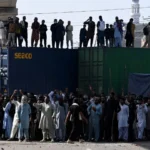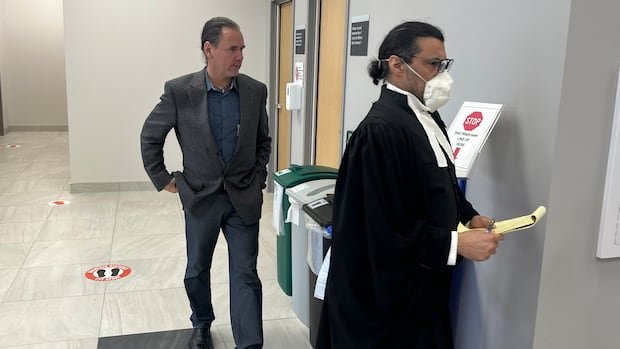WASHINGTON-
Inside the Capitol, it is increasingly difficult to find reminders of the violence.
The scars on the walls have been repaired. Windows and doors broken by rioters have been replaced. And there is no plaque, display or souvenir of any kind.
Lawmakers rarely mention the attack, and many Republicans try to downplay it, echoing President-elect Donald Trump’s claims that the carnage that day is overblown and that the rioters are victims.
In some ways, it is as if the insurrection of January 6, 2021, which shook the foundations of American democracy, never happened.
“It’s been erased,” said Sen. Peter Welch, D-Vermont. “Winners write history and Trump won. And their version is that it was a peaceful meeting. Obviously completely false.”
If Trump pardons the rioters, as he has said he will do after taking office on Jan. 20, that would be “putting an exclamation point on his version of what happened,” Welch said.
Some of the 1,250 defendants convicted of crimes after Jan. 6 called for the deaths of then-House Speaker Nancy Pelosi, D-Calif., and Mike Pence, who was Trump’s vice president, as the mob invaded violently at the police and entered the building. Some carried guns, zip ties, chemical irritants and Confederate flags as they ransacked the Capitol and searched for lawmakers. They attempted to stop the certification of Democrat Joe Biden’s victory over Trump, echoing the incumbent Republican president’s false claims that the election was stolen.
But the interruption was only temporary. Congress resumed its work that night and completed its constitutional function.
Alaska Sen. Lisa Murkowski, one of seven Senate Republicans who voted to convict Trump on impeachment charges after Jan. 6, said “it was a very, very dark time.” Some lawmakers, he said, “really want to put that behind us.”
However, there are different reasons for this.
Former Republican Sen. Mike Braun, a frequent Trump ally who left Congress this year and was elected governor of Indiana, said many in the party think the Justice Department “was disproportionately used as a weapon against” some rioters. He said many lawmakers who were at the Capitol on Jan. 6 want as much distance as possible between then and now.
“I think we all remember that,” Braun said. But, he added, “if you start putting up plaques, it seems to further emphasize the division on the issue. And maybe the biggest remedy is to just keep moving forward.”
The plaque that never happened
Congress passed a law in March 2022 to require “an honorary badge listing the names of all officers of the United States Capitol Police, the District of Columbia Metropolitan Police Department, and other law enforcement agencies and bodies.” comply with federal, state and local laws. protective entities that responded to the violence that occurred at the United States Capitol on January 6, 2021.”
The architect of the Capitol was ordered to obtain the plaque within a year and place it permanently on the west front of the Capitol, where the worst of the fighting took place.
But almost three years later, no plaque remains. It is not clear why or who is responsible. A spokeswoman for the Architect of the Capitol referred questions to the House Sergeant at Arms, who did not respond to requests for information.
Senate Democratic Leader Chuck Schumer of New York and then-Senate Republican Leader Mitch McConnell of Kentucky signed the plaque, according to a Senate leadership aide who was familiar with the process but was not authorized to discuss the matter publicly and spoke on condition of anonymity. House Democratic leader Hakeem Jeffries of New York has also supported it. A spokesman for House Speaker Mike Johnson, R-Louisiana, did not respond to requests for comment.
Rep. Zoe Lofgren, D-Calif., who chaired the House Administration Committee when the law was enacted, wrote to Johnson in May to ask why the plaque had not been installed. “If there is a reason for the delay, I look forward to any information you can share to that end and what is being done to address it,” Lofgren said.
She never received a response.
“It’s not just the badge, although it means something to the officers who were there, but the fact that no one cares enough about them to follow the law and recognize the sacrifice they made for us and our country,” he said. Lofgren. saying. “That service to his country has been disrespectful.”
New York Rep. Joe Morelle, now the top Democrat on the House Administration Committee, said refusing to display the plaque is part of an effort to “deny that Jan. 6 happened and the damage it caused to the United States Capitol Police Force.”
The officers who were there.
Metropolitan Police officer Daniel Hodges, who fought off rioters and was captured on video screaming as he was crushed at a door leading to the inauguration stage, said it is “incredibly offensive” that the plaque has not been installed.
“It’s an incredibly simple thing, but it can mean a lot to many who fought that day to defend democracy, defend Congress, the vice president and the staff,” he said. He said January 6 has become a political issue. “It shouldn’t be like this,” he said.
Hodges said he hopes to work on Inauguration Day, one of thousands of police officers who will protect the president and the city on Jan. 20.
Former Capitol Police Sgt. Aquilino Gonell, who retired due to injuries he sustained fighting rioters near the Western Front Tunnel, said he lost “my career, my health” and even some friends and family after the attack. He and Hodges have been among the few in law enforcement to speak publicly about their experience.
“Looking back, it’s like it was all for nothing,” Gonell said. “It’s a betrayal.”
He said he wishes the plaque was on the west front so Trump could see it before he takes the inauguration stage in a few weeks.
Trump “could read the officers’ names right before he left,” Gonell said. “That way he would know that his actions had consequences.”
Changing the Republican narrative
In the days after the Capitol siege, Republican condemnation was almost universal.
“They’re counting on me,” said Republican Sen. Lindsey Graham of South Carolina, one of Trump’s top allies, on the night of Jan. 6. Then-House Republican leader Kevin McCarthy of California said a week later that Trump “is responsible” for the attack.
But McCarthy soon made peace and traveled to Florida a few weeks later to meet with Trump. It was a fateful decision that began Trump’s slow return to power. When Trump returned to the Capitol last year during his campaign, Republican lawmakers not only met him but also gave him a standing ovation.
During that time, Republican attitudes toward the Jan. 6 attack have changed. Republican lawmakers condemned the work of the Democratic-led committee that investigated the riot and fiercely questioned its conclusions. Some Republicans have echoed Trump’s words that imprisoned rioters are “hostages” who may be worthy of clemency.
Still, the issue may end up being complicated for Trump, who promised pardons on “Day 1.” It is not clear how many people it intends to forgive or whether it would include the most violent offenders.
“If they physically attacked police officers, I don’t think they deserve to be forgiven,” Sen. Markwayne Mullin, R-Okla., one of Trump’s closest allies, said in an interview with CNN. “I think they should serve their time.”
‘Trust in history’
Sen. Catherine Cortez Masto, D-Nev., said there are legacies from the attack even without a plaque hanging on the wall, such as increased security at this year’s certification and Biden’s invitation for Trump to come to the Oval Office. after the elections. , a return to the peaceful transition of power.
“Don’t you think people thought deep down that that was different than January 6?” she said. “That’s how it plays out, it’s important.”
Congress has updated the Electoral Count Act, the arcane law that governs the certification of a presidential election, to make it more difficult for members of Congress to challenge the results.
Still, with Trump back in power and many Republicans backing his version of events, Democrats said they worry that a false Jan. 6 narrative will gain even more traction.
“If you don’t want to remember history, then the chances of it repeating itself are much greater,” said Rep. Jim McGovern, D-Massachusetts. “There should be a moment of silence or some commemoration. There should certainly be a plaque.”
In the days after the insurrection, Rep. Jim Himes, D-Conn., said he thought they should keep a broken window as a reminder. But the windows were replaced, reinforced and cleaned. Little evidence remains of the widespread damage, worth millions of dollars, that rioters inflicted on the building.
It’s “painful” to see attempts to rewrite what happened, Himes said, but he doesn’t believe Jan. 6, 2021, will be forgotten.
“I have confidence in the story,” Himes said.








